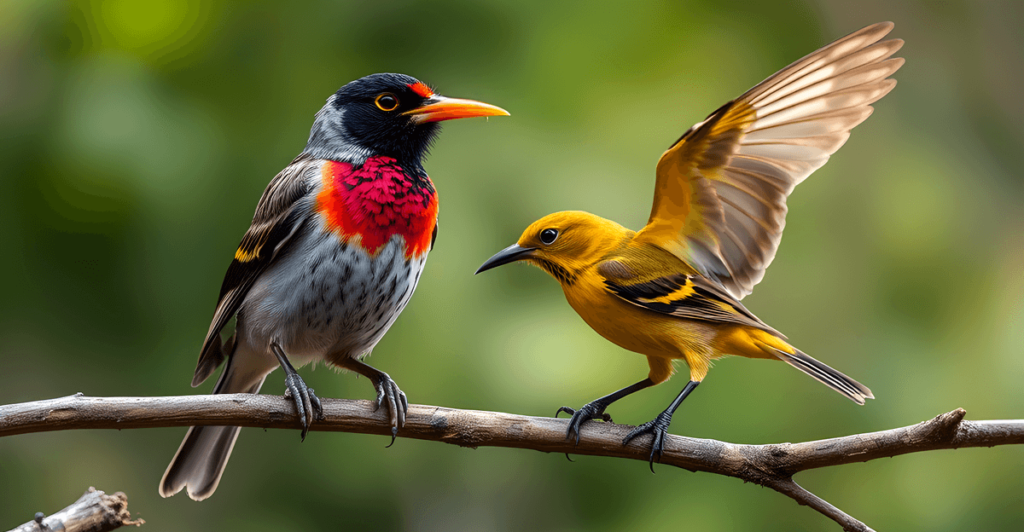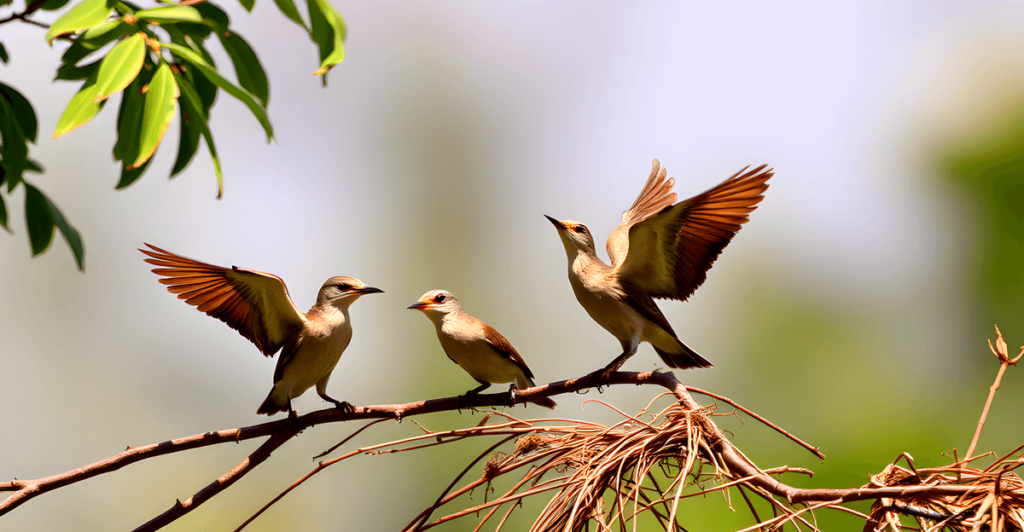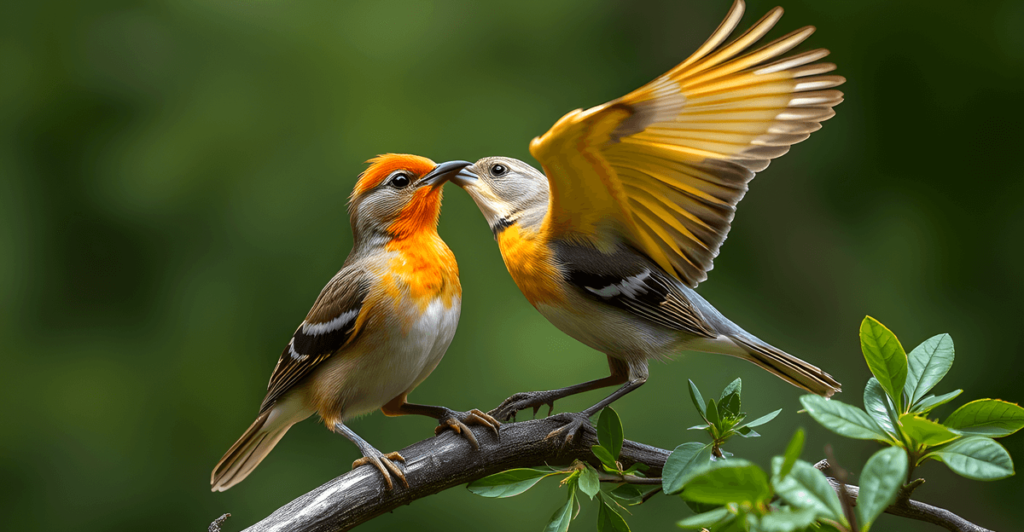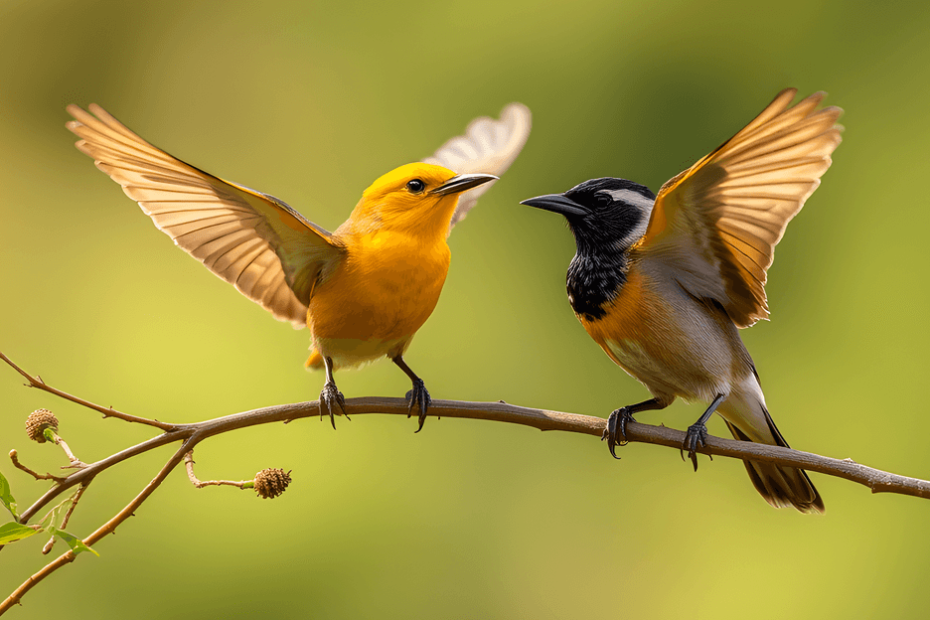Introduction
As an ornithologist with over two decades of field experience, I’ve had the privilege of observing countless bird species in their natural habitats. One question that has always fascinated me is: are birds omnivores? This seemingly simple query opens up a world of complexity and wonder in the realm of avian biology. In this comprehensive guide, I’ll share my personal observations and scientific insights to help you understand the diverse dietary habits of our feathered friends.
Understanding Dietary Classifications
Before we dive into the specifics of bird diets, it’s crucial to understand what we mean by “omnivore.” In my years of studying animal behavior, I’ve come to appreciate the nuances of dietary classifications.
What are Omnivores?
Omnivores are organisms that consume both plant and animal matter. In my field studies, I’ve observed that omnivorous animals display remarkable adaptability in their feeding habits. They can switch between different food sources depending on availability and nutritional needs.
Herbivores, Carnivores, and Omnivores in the Animal Kingdom
To put things in perspective, let’s briefly look at the main dietary classifications:
- Herbivores: Feed exclusively on plant matter
- Carnivores: Consume only animal tissue
- Omnivores: Eat both plants and animals
In my research, I’ve found that these categories aren’t always rigid. Many animals, including birds, can fall somewhere on a spectrum between these classifications.
The Spectrum of Bird Diets
Through my observations, I’ve noticed that bird diets are incredibly diverse. Some species are strict herbivores or carnivores, while many others exhibit omnivorous tendencies. This diversity is one of the factors that makes the study of bird diets so fascinating.
Are Birds Omnivores? The Complex Answer
Now, to address our main question: are birds omnivores? Based on my years of field research and countless hours of bird watching, I can confidently say that many birds are indeed omnivores, but not all.
Many Birds are Omnivores
In my studies across various ecosystems, I’ve observed numerous bird species consuming both plant and animal matter. For instance, I once watched a group of American Robins feast on earthworms in the morning and then switch to berries in the afternoon. This flexibility in diet is a hallmark of omnivory.
Variations Among Bird Species
However, it’s important to note that not all birds are omnivores. In my travels, I’ve encountered species that are specialized feeders. For example:
- Hummingbirds: Primarily nectarivorous, though they also eat small insects
- Hawks: Strictly carnivorous, feeding on small mammals and other birds
- Parrots: Mostly herbivorous, with a diet consisting mainly of fruits, nuts, and seeds
Factors Influencing Bird Diets
Through my research, I’ve identified several factors that influence a bird’s diet:
- Habitat: The available food sources in a bird’s environment
- Season: Changes in food availability throughout the year
- Beak shape: Adaptations for specific types of food
- Body size: Larger birds often require more diverse diets
- Metabolic needs: Especially important during breeding and migration

Common Omnivorous Bird Species
In my fieldwork, I’ve had the opportunity to observe many omnivorous bird species up close. Here are some notable examples:
Crows and Ravens
These intelligent corvids are perhaps the epitome of avian omnivores. I’ve watched crows eat everything from fruits and grains to small animals and even carrion. Their problem-solving abilities often lead them to novel food sources.
Seagulls
During my coastal studies, I’ve seen seagulls consume a wide variety of foods. From fish and mollusks to discarded human food and even other birds’ eggs, their opportunistic feeding habits are truly remarkable.
Robins
American Robins, common in many North American backyards, are classic examples of omnivores. In my garden observations, I’ve noted them eating worms, insects, and berries with equal enthusiasm.
Blue Jays
These colorful birds have a diverse diet. I’ve observed them eating nuts, seeds, insects, and even small vertebrates. Their omnivorous nature allows them to thrive in various habitats.
Other Notable Omnivorous Birds
In my travels, I’ve encountered many other omnivorous bird species, including:
- Starlings
- Mockingbirds
- Blackbirds
- Grackles
- Many species of gulls and terns
Bird Diet Specializations
While many birds are omnivores, it’s fascinating to explore the dietary specializations that have evolved in certain species. My research has led me to study birds with highly specialized diets:
Herbivorous Birds
Some birds have adapted to feed primarily on plant matter. In my studies of tropical ecosystems, I’ve observed species like the Hoatzin, which has a specialized digestive system for fermenting leaves, much like a cow.
Carnivorous Birds
Birds of prey, such as eagles, hawks, and owls, are exclusively carnivorous. I’ve spent many hours watching these majestic birds hunt, and their adaptations for a meat-based diet are impressive.
Insectivorous Birds
Many small birds, like swallows and flycatchers, specialize in catching insects on the wing. During my field studies, I’ve marveled at their agility and precision in capturing tiny flying prey.
Frugivorous Birds
In tropical forests, I’ve observed birds like toucans and hornbills that primarily eat fruit. Their large beaks are perfectly adapted for reaching and manipulating various fruits.
Nectarivorous Birds
Hummingbirds are the most well-known nectarivores. In my work with these tiny marvels, I’ve seen how their long beaks and specialized tongues allow them to extract nectar from flowers efficiently.
Anatomy and Adaptations of Omnivorous Birds
One of the most fascinating aspects of my research has been studying the physical adaptations that allow birds to be successful omnivores.
Beak Shapes and Functions
The diversity of beak shapes in omnivorous birds is astounding. In my examinations, I’ve noted how beak structure correlates with dietary habits:
- Conical beaks (like those of finches): Good for cracking seeds and catching insects
- Hooked beaks (as seen in gulls): Useful for tearing meat and manipulating various food items
- Generalist beaks (like those of crows): Versatile for handling a wide range of foods
Digestive System Adaptations
Omnivorous birds often have adaptable digestive systems. In my dissection studies, I’ve observed how their digestive tracts can process both plant and animal matter efficiently. Many omnivorous birds have:
- A muscular gizzard for grinding food
- A crop for storing food temporarily
- A relatively short intestine compared to strict herbivores
Sensory Adaptations for Finding Diverse Food Sources
Omnivorous birds often have well-developed senses to help them locate various food types. In my behavioral studies, I’ve noted:
- Excellent color vision for identifying ripe fruits
- Keen hearing for detecting insect movements
- A good sense of smell (in some species) for locating carrion or other food sources

Seasonal Changes in Bird Diets
One of the most intriguing aspects of bird dietary habits that I’ve observed over the years is how they change with the seasons.
How Seasons Affect Food Availability
In my long-term studies, I’ve noticed dramatic shifts in food availability throughout the year. For example:
- Spring brings an abundance of insects and new plant growth
- Summer offers a variety of fruits and seeds
- Fall provides harvest leftovers and migrating insects
- Winter often requires birds to rely on stored foods or switch to alternative sources
Dietary Shifts in Omnivorous Birds
Omnivorous birds are particularly adept at adjusting their diets to seasonal changes. I’ve observed American Robins, for instance, switching from a diet rich in earthworms in the spring to one dominated by berries in late summer and fall.
Migration and Its Impact on Bird Diets
For migratory omnivorous birds, dietary flexibility is crucial. In my studies of migration patterns, I’ve noted how birds like warblers might feed heavily on insects during breeding season in northern latitudes, then switch to a more fruit-based diet during migration and in their winter grounds.
The Ecological Role of Omnivorous Birds
Through my years of ecosystem studies, I’ve come to appreciate the significant ecological roles that omnivorous birds play.
Seed Dispersal
Many omnivorous birds consume fruits and then disperse the seeds through their droppings. I’ve tracked seed dispersal patterns in forest ecosystems and found that birds like thrushes and jays play a crucial role in forest regeneration.
Pest Control
The insectivorous tendencies of many omnivorous birds make them excellent natural pest controllers. In agricultural areas, I’ve observed how birds like starlings and blackbirds can significantly reduce insect populations.
Pollination
While not as specialized as nectarivores, some omnivorous birds do contribute to pollination. During my studies of flowering plants, I’ve seen orioles and sunbirds inadvertently transfer pollen while feeding on nectar.
Impact on Ecosystems
The dietary flexibility of omnivorous birds allows them to adapt to and influence various ecosystems. In my research, I’ve noted how these birds can:
- Maintain balance in food webs
- Contribute to nutrient cycling
- Influence plant community composition through selective feeding
Evolution of Omnivory in Birds
The evolution of omnivory in birds is a topic that has fascinated me throughout my career. My research into fossil records and comparative biology has revealed some interesting insights.
Ancestral Bird Diets
Most evidence suggests that the earliest birds were likely insectivores. In my paleontological studies, I’ve examined fossils that indicate early birds had teeth and claws adapted for catching and eating insects.
Evolutionary Advantages of Omnivory
The shift towards omnivory in many bird lineages offers several advantages:
- Dietary flexibility: Allows survival in varied environments
- Reduced competition: Access to a wider range of food sources
- Nutritional balance: Ability to meet diverse nutritional needs
- Adaptability: Better chances of surviving environmental changes
Case Studies of Diet Evolution in Bird Species
In my research, I’ve closely studied several bird species that demonstrate interesting dietary evolutions:
- Darwin’s Finches: A classic example of adaptive radiation, with beak shapes evolving to exploit different food sources on the Galápagos Islands.
- New Zealand Kea: Originally forest dwellers, these parrots have adapted to a more omnivorous diet as they moved into alpine regions.
- Urban Pigeons: I’ve observed how city-dwelling pigeons have adapted to consume a wide variety of human food scraps, showcasing rapid dietary adaptation.
Feeding Omnivorous Birds in Your Backyard
As someone who has spent years studying bird feeding behaviors, I can offer some insights on attracting and supporting omnivorous birds in your backyard.
Types of Food to Offer
Based on my observations, here’s a list of foods that attract a variety of omnivorous birds:
- Seeds: Sunflower, safflower, millet
- Fruits: Apples, grapes, berries
- Nuts: Peanuts, almonds, walnuts
- Suet: Especially attractive in winter
- Mealworms: Live or dried
- Nectar: For hummingbirds and some omnivores
Creating a Diverse Feeding Station
In my own backyard bird sanctuary, I’ve found success with a multi-feeder approach:
- Platform feeders for larger birds
- Tube feeders for smaller species
- Suet cages for woodpeckers and other clinging birds
- Ground feeding areas for birds like doves and towhees
Seasonal Considerations for Bird Feeding
Through my year-round observations, I’ve noted the importance of adjusting your feeding strategy with the seasons:
- Spring/Summer: Offer more protein-rich foods for breeding birds
- Fall: Provide high-fat foods to help with migration
- Winter: Maintain a consistent food supply when natural sources are scarce
Challenges Faced by Omnivorous Birds
In my conservation work, I’ve become acutely aware of the challenges facing omnivorous birds in today’s changing world.

Habitat Loss and Food Scarcity
Urban expansion and agricultural intensification have led to significant habitat loss. I’ve witnessed firsthand how this affects omnivorous birds:
- Reduced diversity of food sources
- Increased competition for limited resources
- Forced adaptation to human-altered environments
Climate Change Impacts on Food Sources
Through long-term studies, I’ve observed how climate change is altering food availability for birds:
- Shifts in plant flowering and fruiting times
- Changes in insect emergence patterns
- Alterations in migration timing that may not align with food availability
Competition with Specialized Feeders
In some ecosystems, I’ve noted increased competition between omnivorous birds and more specialized feeders:
- Nectarivores outcompeting omnivores for flower resources
- Specialized insectivores more efficient at capturing certain prey types
- Herbivores consuming fruits before they ripen enough for omnivores
Research and Studies on Bird Diets
As a researcher, I’ve been involved in and closely followed numerous studies on bird diets. Here’s an overview of some key aspects:
Methods for Studying Bird Diets
In my fieldwork, I’ve employed various methods to study bird diets:
- Direct observation: Watching birds feed in their natural habitat
- Fecal analysis: Examining bird droppings for undigested food remains
- Stomach content analysis: For deceased specimens
- Stable isotope analysis: To determine long-term dietary patterns
- DNA barcoding: Identifying food items from trace DNA
Recent Findings in Ornithology
Some exciting recent discoveries in bird diet research include:
- The discovery of omnivory in some traditionally considered herbivorous parrots
- Evidence of tool use in some corvids to access new food sources
- The impact of urban environments on bird diets and feeding behaviors
Ongoing Research Projects
I’m currently involved in several research projects related to bird diets:
- A long-term study on the impact of climate change on migratory bird diets
- An investigation into the role of omnivorous birds in seed dispersal in fragmented habitats
- Research on the nutritional ecology of urban birds and their adaptation to human food sources
Misconceptions About Bird Diets
Throughout my career, I’ve encountered many misconceptions about bird diets. Let’s address some common myths:
Common Myths About What Birds Eat
- Myth: All birds eat seeds.
Reality: While many birds eat seeds, there’s a wide variety of specialized diets among bird species. - Myth: Birds can eat any human food.
Reality: Some human foods can be harmful or even toxic to birds. - Myth: All small birds are insectivores.
Reality: Many small birds are omnivores or have specialized diets.
Clarifying the Omnivore Status of Popular Bird Species
In my public education efforts, I often need to clarify the dietary habits of well-known birds:
- Penguins: Often thought to eat fish exclusively, some species also consume squid and krill.
- Hummingbirds: While known for nectar feeding, they also require insects for protein.
- Flamingos: Their pink color comes from eating algae and small crustaceans, not just from eating shrimp as commonly believed.
Addressing Misunderstandings About Bird Nutrition
One of the most common misunderstandings I encounter is the belief that a single type of food can meet all of a bird’s nutritional needs. In reality, most birds require a varied diet to obtain all necessary nutrients.
The Future of Omnivorous Birds
As an ornithologist deeply concerned about conservation, I often ponder the future of omnivorous birds in our changing world.
Adaptations to Changing Environments
In my urban ecology studies, I’ve observed impressive adaptations by omnivorous birds:
- Crows learning to use traffic patterns to crack nuts
- Gulls developing new feeding strategies at landfills
- Urban birds adjusting their singing times to avoid noise pollution
Conservation Efforts for Diverse Habitats
My work with conservation organizations has highlighted the importance of preserving diverse habitats:
- Protecting migration stopover sites
- Restoring degraded urban and suburban green spaces
- Maintaining connectivity between different habitat types
Potential Dietary Shifts in Response to Global Changes
Based on current trends, I predict we may see:
- Increased omnivory in some traditionally specialized feeders
- Shifts in migration patterns to align with food availability
- Possible dietary adaptations to new food sources, including invasive species
Conclusion
After decades of studying bird diets, I can confidently say that the question “Are birds omnivores?” doesn’t have a simple yes or no answer. While many birds do exhibit omnivorous tendencies, the world of avian diets is incredibly diverse and complex.
